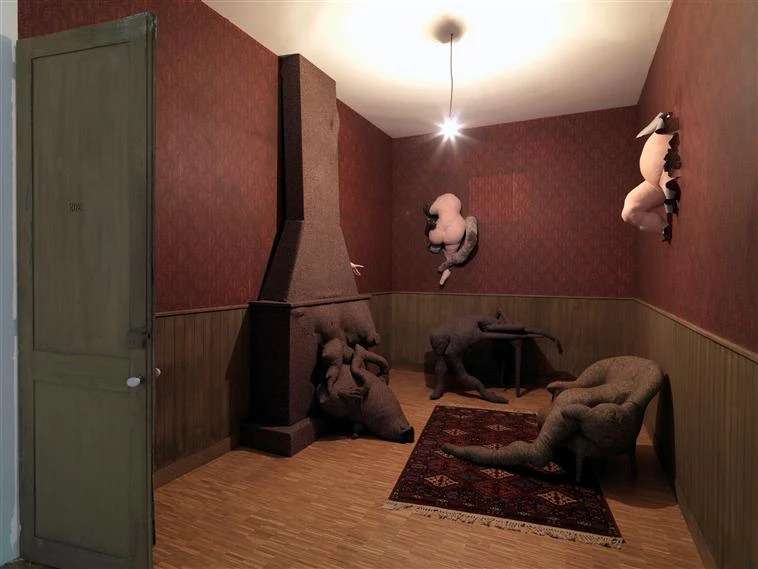‘Practice’ Writing task – 701
Hôtel du Pavot, Chambre 202 (Poppy Hotel, Room 202)
1970-73 Fabric, wool, synthetic fur, cardboard, and Ping-Pong balls 133 7/8 x 122 1/8 x 185 in.
Musée National d’Art Moderne, Centre Georges Pompidou, Paris
(Meguerditchian, 1977)
Hôtel du Pavot, Chambre 202 (Poppy Hotel, Room 202) by Surrealist artist Dorothea Tanning is made up of recycled fabric forms hand sewn by Tanning on her Singer sewing machine. Human like forms are installed within a makeshift hotel room escaping and morphing in and out of the space. In relation to ‘Practice’ this work represented a change to Tanning’s making process in terms of her approach to challenging new materials, ways of working and thinking. Up until the mid sixties Tanning had established herself as one of the leading female Surrealist painters of her time when she had the creative urge to pursue new means to make work:
‘One day I got fed up with the turpentine, really fed up… setting myself terrible goals, terrible challenges’ (Tate Shots, 2019)
This new approach for Tanning resonates for me as I explore new materials and ways of working for my proposal for Masters Study. For me change is important, like punctuation in my practice as I move forward and challenge myself continually pushing onwards. This continuous thread of internal thinking and external making are what I see as practice. There are many elements which contribute to this need for the artist to experiment and discover creatively. This is summed up in the theory of philosopher and artist Kathleen Coessens (2014) who describes what she refers to as the ‘Web of Artistic Practice’:
Many decisions and trials of artistic creation are prepared in the exploration phase, hidden from the public. Artists continuously integrate different tacit dimensions – embodied expertise, personal knowledge, ecological environment-cues, cultural semiotic codes and interactivity. These dimensions can become an explicit part of an artist’s detailed practices and research.
Dorothea Tanning’s expertise and knowledge from her painting career, her move to Sedona Arizona and associations with the painters of the time would have all been contributing factors to the evolution of this large scale soft sculpture. Tanning saw change as a progression in her practice as a whole describing the work of Hôtel du Pavot, Chambre 202 as a;
‘parallel expressions of the same preoccupations. That is, the sculptures bring into a three-dimensional reality the visions which have all my life lived their two-dimensional lives on canvas. ‘(Levi-Strauss 1976)
It could be argued that any completed work of art such as Hôtel du Pavot, Chambre 202 reveals only the conclusion of practice and that the actual practice is the discovery though making as the artist works towards the final piece. The practice is that which comes from the initial idea right up to but not including the final outcome.
Bibliography
Meguerditchian, G. (1977) Chambre 202, Hôtel du Pavot. Available at: https://www.centrepompidou.fr/cpv/resource/cbqLyBq/rXbpaMA (Accessed: 10 October 2019)
Tate Shots (2019) Dorothea Tanning – Pushing the boundaries of Surrealism. Available at: https://www.tate.org.uk/whats-on/tate-modern/exhibition/dorothea-tanning (Accessed: 09 October 2019)
Coessens, K (2014) The web of Artistic Practice: A background for Experimentation Leuven University Press
Levi-Strauss, M. (1976) ‘Dorothea Tanning: Soft Sculptures’ American Fabrics and Fashions, pp. 69. Available at: https://www.dorotheatanning.org/images/Levi-Strauss%20Interview%20in%20Am%20Fabrics%20and%20Fashions.pdf (Accessed: 07 October 2019).

Recent Comments